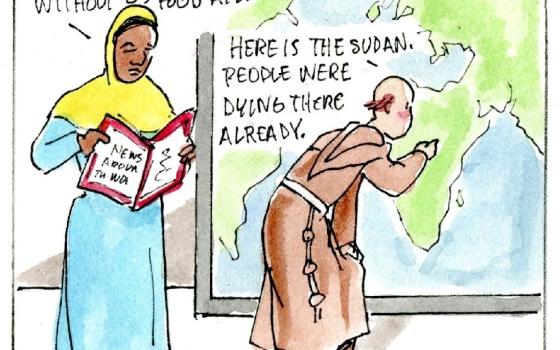
Jack Huston and Toby Kebbell in "Ben-Hur" (Paramount Pictures/ Philippe Antonello)
Coming to theaters Aug. 19, the fourth cinematic adaptation of Lew Wallace's 1880 novel Ben-Hur: A Tale of the Christ is a reimagining for the 21st century. The first, in 1907, was a silent short film and made without permission from Wallace's family. The heirs took the filmmakers to court over copyright infringement and it ended with the Supreme Court setting a legal precedent for film and theatrical adaptations of literary works.
Carol Wallace, Wallace's great-great-granddaughter, was at the press screening I attended at Paramount Studios for the 2016 film "Ben-Hur" and announced that she had transformed the "old fashioned prose" of the original novel for a new audience; the book is to be released around the time of the film. She is very pleased with the new film.
Around A.D. 25, Judah Ben-Hur (Jack Huston), a Jewish prince, and his best friend and adopted brother Messala (Toby Kebbell) race their horses near Jerusalem. Messala, who is a Roman, leaves Jerusalem to join the army. Judah, a man of peace, becomes a leader in the Jewish community.
When Messala returns after five years, he and Judah pick up their friendship, to the joy of Judah's sister, Tirzah (Sofia Black-D'Elia), and mother, Naomi (Ayelet Zurer). Meanwhile, Judah has married Esther (Nazanin Boniadi).
Messala, seeking to advance his military career, asks Judah to gather information on the Jews who are fighting the Roman occupation. Judah agrees to talk to them, but when Messala returns, he wants Judah to name names. Judah, however, explains that he believes that peaceful negotiations are the best way for the Jews to deal with the Romans and he has asked the zealots to end their violence. Judah refuses to give up any of his Jewish brothers and sisters. Messala angrily leaves the house.
As the new Roman governor, Pontius Pilate (Pilou Asbæk), enters Jerusalem, the army marches past the Ben-Hur palace. It is then that a young Jewish boy named Dismas, whom Judah has let stay in his stables to heal from wounds received while attacking the Romans, shoots an arrow at the governor from the rooftop where Judah and his family are watching. Shocked, Judah helps the boy escape and then takes the blame. Messala, at Pilate's command, sentences Judah to life as a galley slave rowing Roman ships and sends Tirzah and Naomi to prison.
Years later, after a harrowing sea battle, Judah escapes and washes ashore near his homeland. Sheik Ilderim (Morgan Freeman), a dedicated horseman, takes Judah in. When Judah realizes that Messala will be racing in the chariot competition, he first proves his ability as a horseman to Ilderim, who then arranges to have Judah join the race.
The desire to find out what happened to his mother and sister and to take down Messala in the chariot race motivates Judah almost beyond reason. He encounters his wife, who has spent these years serving others with a holy man named Jesus to make up for running away when Judah was captured. She tries to convince Judah that vengeance is empty and useless, but he will not listen.
The day of the chariot race dawns and it is a spectacle without compare -- even against the chariot race in William Wyler's 1959 epic "Ben-Hur," starring Charlton Heston.
The 1959 version runs three and a half hours. The new interpretation is almost two hours shorter. The plot lines, while still complex, are thinned out, and the roles of some characters have been either deleted or abbreviated, and some names are changed. For example, Ben-Hur's rescue of Quintus (James Cosmos), the warship commander, doesn't happen; something else does that reflects Judah's descent into a prison of anger.
The filmmakers are hoping that the main characters played by Huston ("Boardwalk Empire") and Kebbell ("Fantastic Four") are more familiar to millennials than those of us who have seen the Heston version many times. The focus here is on the fractured friendship and healing of the two men who are brothers and friends, Judah Ben-Hur and Messala. Freeman, who plays Il-derim, is a superb choice that adds age and gravitas to the film. He also appeals to an intergenerational audience.
John Ridley, who wrote the Oscar-winning script for "12 Years a Slave," had reservations about revisiting this story, concerned that audiences might think a remake would disrespect the 1959 version. (Ridley took over from screenwriter Keith R. Clarke.)
Ridley noted in a statement to The Christian Post, "The emotional themes of the film, vengeance vs. forgiveness, are timeless," and, "Judah Ben-Hur is a rich, classic character. He's a wronged man seeking revenge and redemption. ... I wanted to make the personal conflict between these former friends just as tense as the chariot race."
The film is expertly directed by Timur Bekmambetov ("Wanted"; "Abraham Lincoln: Vampire Slayer"), who told film journalists that the filmmakers consulted NASCAR and Formula One YouTube videos for the chariot race techniques. The race was entirely shot "in camera" -- that is, shot out of doors as the action happened. The only special effects added were the horses (none were injured in the making of this film), and security procedures were in place to protect Huston and Kebbell, who did their own chariot driving, in case of runaway horses or a crash.
For the sea battle, the camera sees everything through Judah's eyes and experience. The horror of his slavery, suffering, and growing hate and anger is profound. But while the sea battle is awe-inspiring, the chariot race is mind-blowing. It really draws you in.
My one major issue with the film, as with all films dealing with Jesus, is the costuming of the Jews. Once again, care is given to the Romans, but the dress of the Ben-Hur family, certainly observant Jews, seems completely uninformed. I brought this up to costume designer Varvara Avdyushko, a frequent collaborator with Bekmambetov, and she told me: "No one knows what Jewish women wore at that time."
That's not really accurate.
In one scene, Ben-Hur and his bride, Esther, are riding horses. She is dressed in tight white pants with a long white shift, and sitting astride. Naomi and Tirzah's clothing was low cut, and Naomi's hair was not covered.
I consulted Daniel Sperber, a professor of Talmud at Bar-Ilan University in Israel about Jewish dress around the year 30. He not only recommended four books to me (one in English and three in German), but wrote: "It is unlikely that first century Jewish women would wear tight pants. It would be rare for them to ride a horse, but if they did I suspect it would be sidesaddle. As for Jewish royalty: if deeply influenced by the Romans -- i.e. put into position by the Roman administration, they might be dressed not so modestly. I am sure, however, that, if married, [they] would have very fancy head covering."
The Ben-Hur family was royal but not part of the Roman administration. I think Hollywood and those making films of interest to the Christian audience need to do better in how they depict our Jewish brothers and sisters.
The face of Jesus has never been shown in a theatrical or film version of "Ben-Hur" before now. While this disappointed me, a lover of the original novel and the 1959 film, Daughter of St. Paul Sr. Nancy Usselmann, who attended the screening and had only seen the 1959 version once a long time ago, thought this portrayal of Jesus (Rodrigo Santoro) worked very well. She said the film is "fantastic."
This 3-D, action-filled production of "Ben-Hur" is epic and beautifully filmed, the direction and acting are very good, and the adaptation will appeal to a new audience as well as to aficionados of the past -- if they can only let go of Heston. In the cut we saw a few weeks ago, the music had not yet been set, but I can imagine that the prolific Oscar-nominated composer Marco Beltrami will do a fine job.
The overall themes of brotherhood, anger, vengeance, forgiveness, love, hate and reconciliation are obvious. Though perhaps there could have been more subtlety with the themes, the spectacular action sequences even out the whole. The role of Jesus in Ben-Hur's life and the shedding of his blood on the cross for humanity are finely integrated.
For those of us who know the 1959 version well, no comparison is useful. Put it completely out of your mind. See it fresh and through the eyes of teens and young adults.
Did I mention that the chariot race is completely awesome?
Updated, 10 a.m. CDT, Aug. 18, with Sr. Rose Pacatte's video review and interview with Toby Kebbell, who plays Messala.
[Sr. Rose Pacatte, a member of the Daughters of St. Paul, is the director of the Pauline Center for Media Studies in Los Angeles.]



